

Matt Campbell
2026 Hyundai Tucson Hybrid review
23 Hours Ago
The most basic Outlander Plug-in Hybrid EV is one of the most compelling PHEV options on the market right now – here's why.
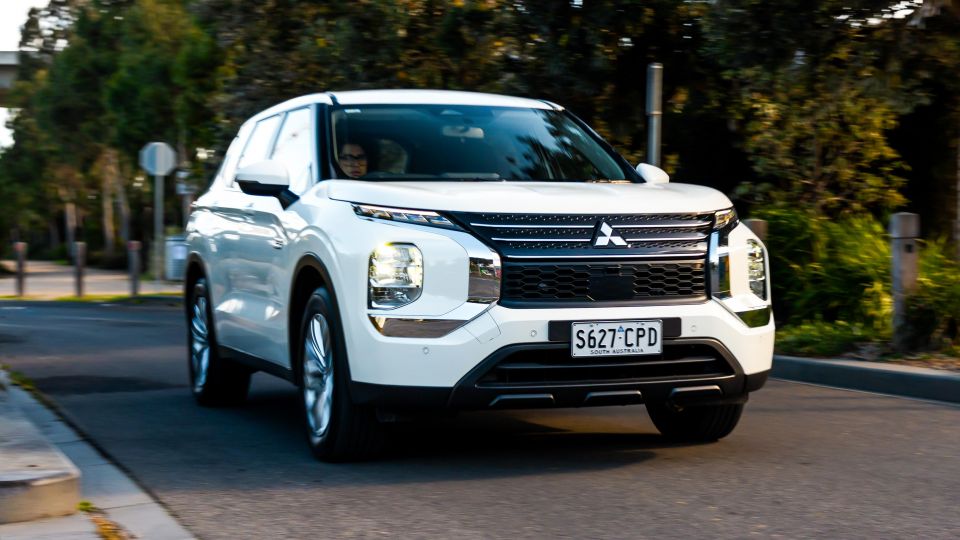
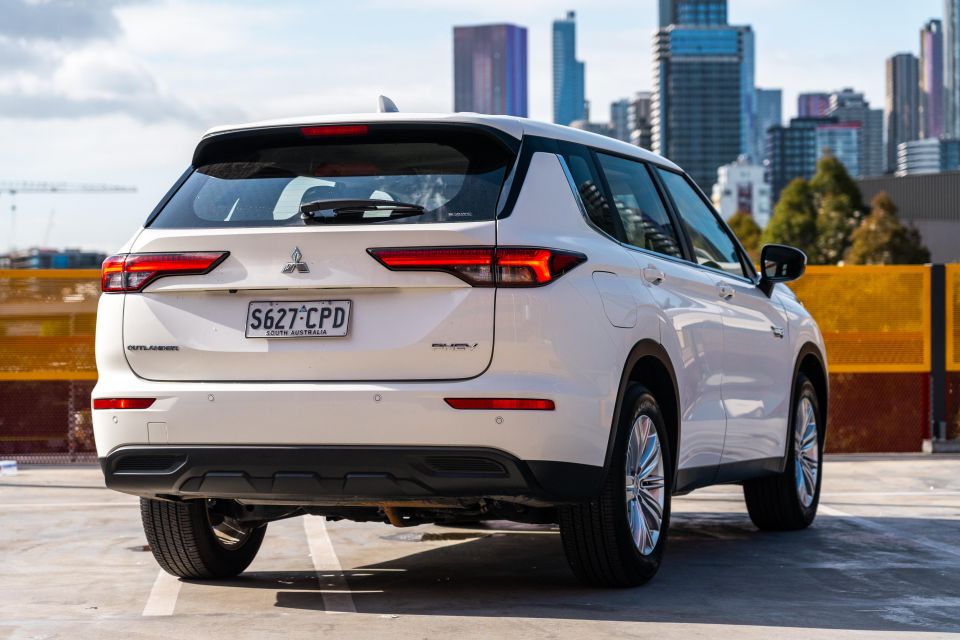

Quickly see how this car stacks up against its competition. Select any benchmark to see more details.
Where expert car reviews meet expert car buying – CarExpert gives you trusted advice, personalised service and real savings on your next new car.
While plug-in hybrids (PHEVs) are a small corner of the Australian market, the Mitsubishi Outlander is one of the few vehicles that has seemed to make the tech stick.

It was one of the first vehicles to offer a plug-in hybrid system back in 2014, and has garnered a loyal following from buyers wanting electric daily driving ability and a combustion engine for longer trips.
Conventional hybrids and pure electric vehicles have taken centre stage of late, with PHEVs languishing on the sales charts in Australia by comparison.
EV sales in 2022 across Australia tallied 33,410 units, while regular hybrids found 81,786 buyers. PHEVs, meanwhile, managed just 5937 sales.
Unlike most other brands that limit PHEV options to a single, high-spec trim level with a lofty price tag, Mitsubishi is one of few to offer multiple trim levels – including an attainable entry-level model.
Here on test we have the Mitsubishi Outlander Plug-in Hybrid EV ES, a fleet-focused base model that eschews luxuries to deliver a starting price within reach of petrol and diesel rivals.
It costs almost $17,000 more than the equivalent petrol Outlander, but the base PHEV is around the same money as a Toyota RAV4 Edge AWD Hybrid, which as we know is in-demand and subject to long wait times.
Does the Outlander PHEV pack enough goodness at the base level to sway you from high-spec alternatives?
At $56,490 before on-road costs, the entry-level Outlander PHEV ES is about the same price as a top-spec RAV4 Hybrid.
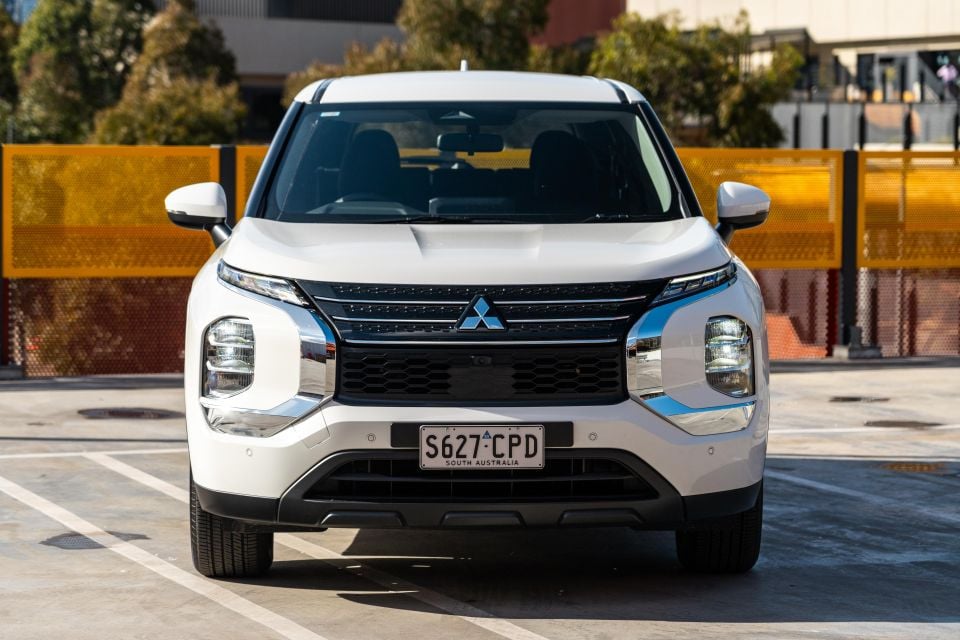
That’s up $900 on the 2022 range, offset with additional equipment including auto high-beam, rear cross-traffic alert, and AEB in reverse.
You have to spend up for the Exceed ($67,490) and Exceed Tourer ($69,990), to get the MI-Pilot semi-autonomous driving assist system which adds Traffic Jam Assist and lane centring to the standard adaptive cruise control system.
Unlike the petrol Outlander ES, the PHEV ES isn’t available with seven seats, instead having to again opt for the more expensive Exceed and Exceed Tourer versions.
The Outlander PHEV ES has few direct plug-in hybrid rivals, although it’s in the ballpark of several conventional hybrid alternatives.
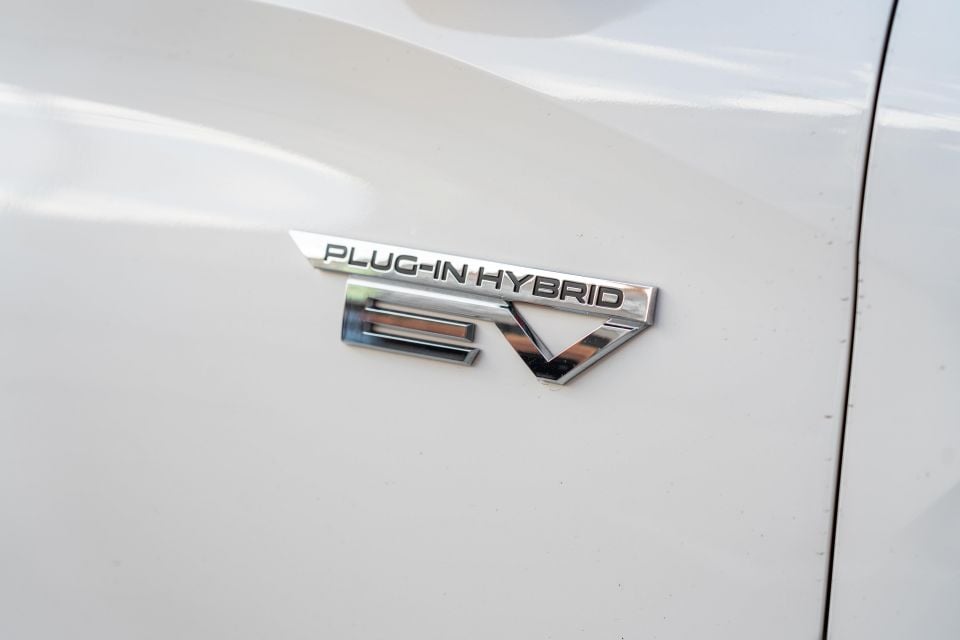
Perhaps this version’s closest like-for-like competition is Mitsubishi’s own Eclipse Cross Plug-in Hybrid EV Exceed, which at $55,990 and runs a very similar (if previous generation) PHEV system underneath.
The aforementioned Toyota RAV4 Edge AWD Hybrid is $58,360 before on-roads, which is the flagship specification with all the fruit. Similarly, the related Nissan X-Trail is available in series-hybrid Ti-L e-Power with e-4orce guise from $57,690.
There’s also the new-generation Honda CR-V e:HEV RS now on sale for $59,900 drive-away, which shapes as a bargain here. Unlike the Toyota, Nissan, and Honda, however, the Outlander offers extended EV range (up to 84km NEDC).

2023 Mitsubishi Outlander Plug-in Hybrid EV pricing:
Prices exclude on-road costs
Buy your new car without the stress. It's fast, simple and completely free.

Great service from Travis and team, second time I have used this business would not hesitate to recommend them to anyone
Craig C.
Purchased a Ford Ranger in Sunshine Coast, QLD
CarExpert helped Craig save thousands on his Ford Ranger, now let us save you on your next new car.
Find a dealWhile there are some clear indicators this is a base model, opting for the PHEV dresses up the cabin slightly.
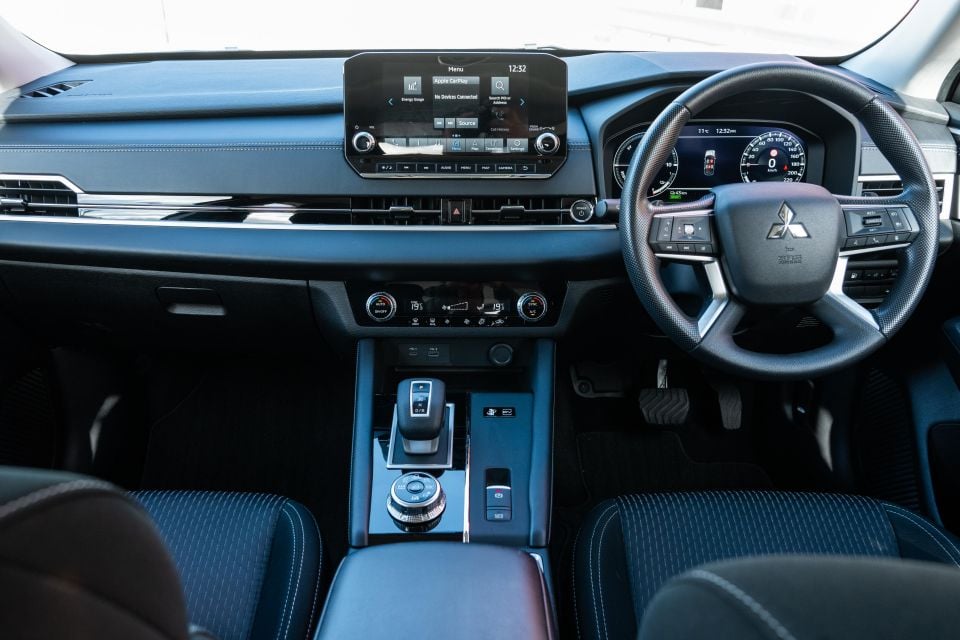
The key differences are in infotainment and display tech, which can really help to lift the ambience.
Ahead of the driver you get a 12.3-inch digital instrument cluster usually reserved for higher grades of the petrol range, while the 9.0-inch infotainment touchscreen gains an inch over the petrol ES’s unit and offers embedded navigation as well as wireless Apple CarPlay and Android Auto connectivity.
That cluster sits behind a plastic steering wheel, which is the real reminder that you have the base model. It’s also not a tactile delight, particularly given the price point.
The seats are trimmed in cloth, but the generously padded and bolstered front pews are comfortable, and offer good levels of adjustment, particularly for the driver. I was pretty happy sitting there for extended periods of time.
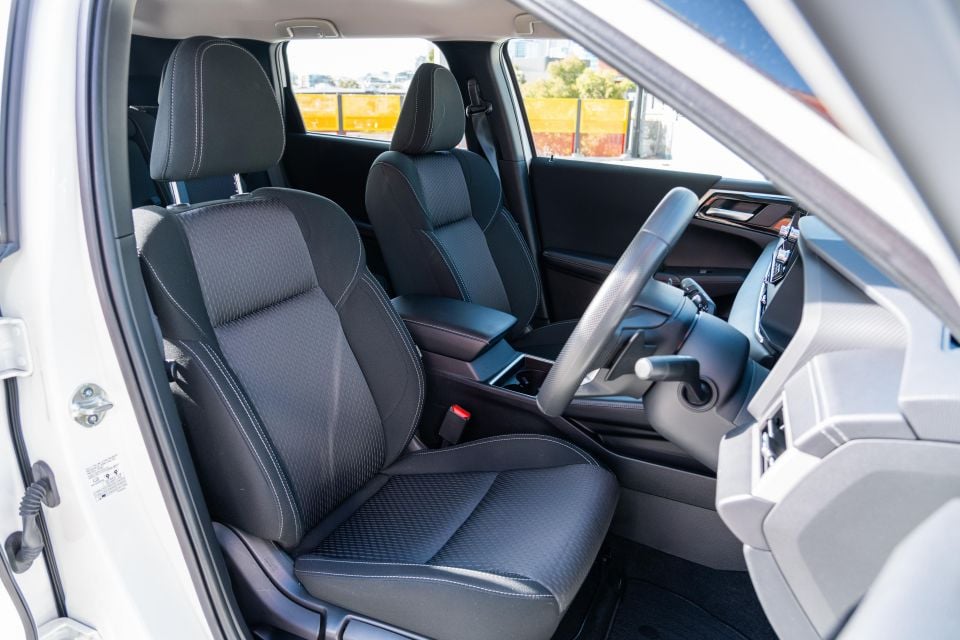
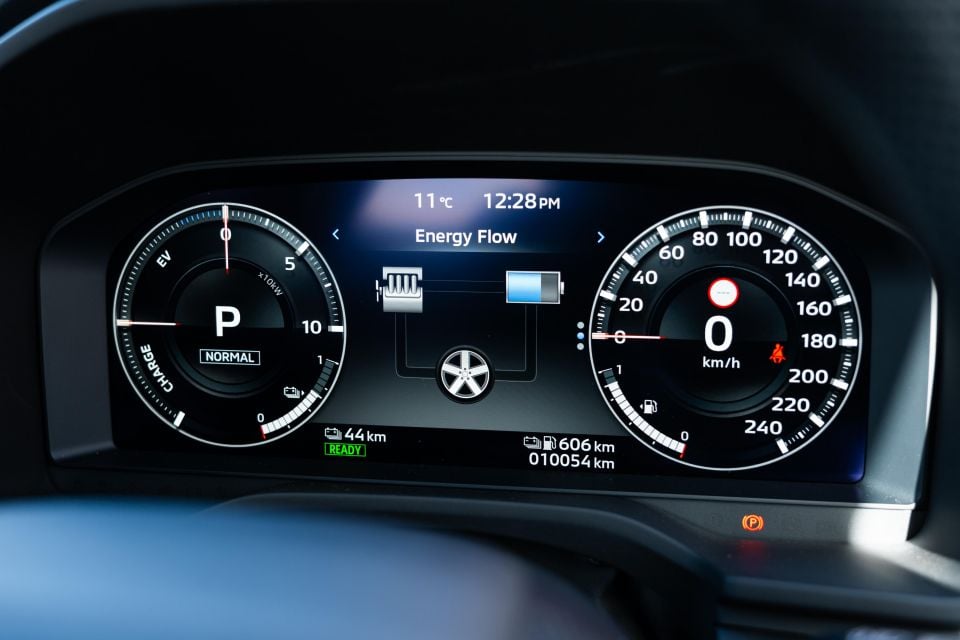
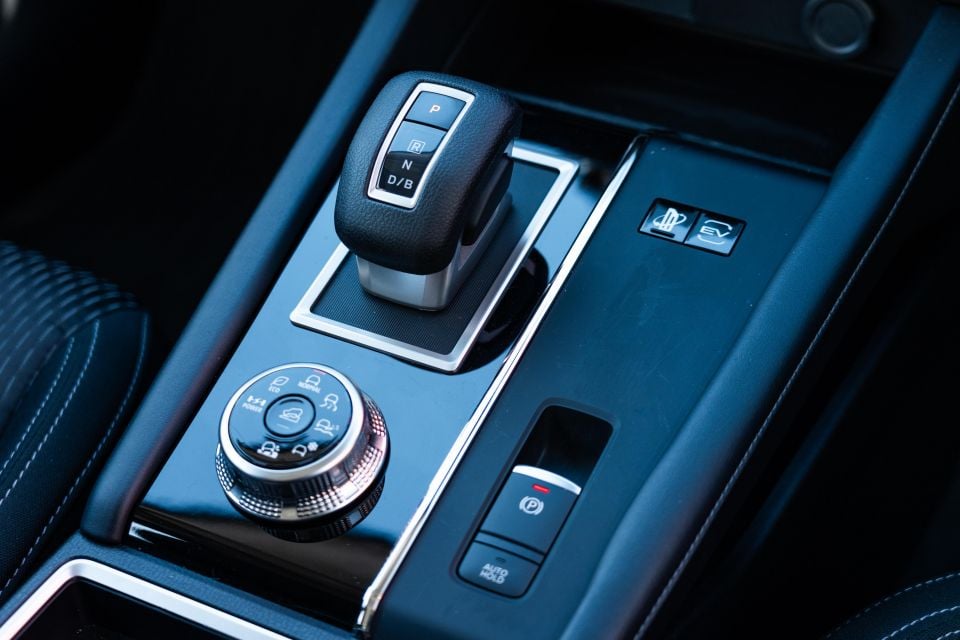
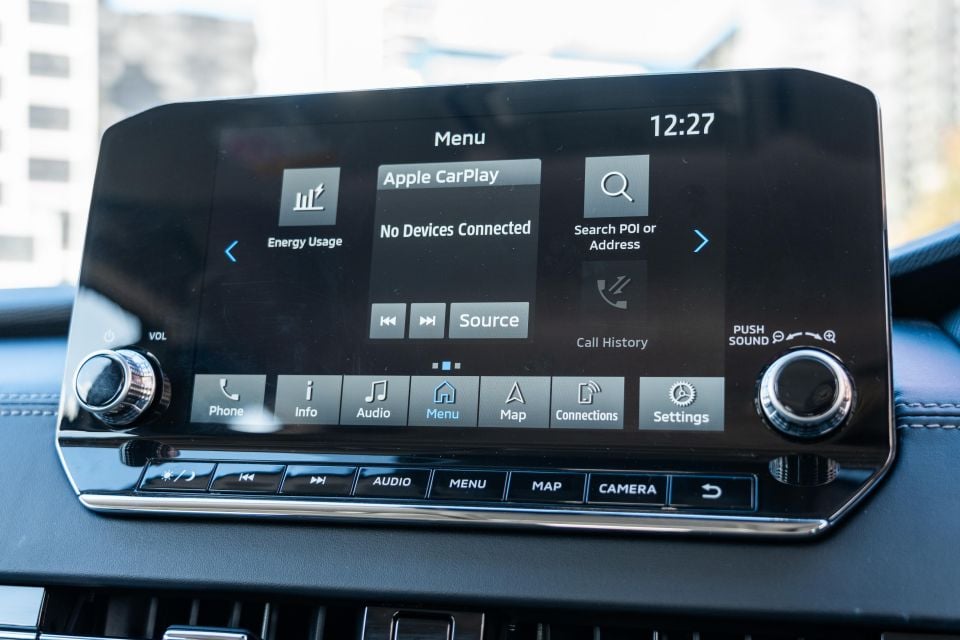
Overall material and build quality is solid, and a huge step up on the previous Outlander – which was arguably dated from the moment it hit the market. That said, the X-Trail feels more premium being effectively the same car under the skin.
There’s a good ratio of soft-touch plastics on high-traffic surfaces, though bits like the door cards and centre console have hard, scratchy plastics that aren’t nice to touch. That plastic steering wheel likewise dulls the otherwise strong presentation.
The high-grade digital instrument cluster and infotainment touchscreen go a long way to elevate the cabin, with crisp graphics and load times, as well as a competitive level of functionality and user-friendliness.
While the infotainment system was generally trouble-free, I had a few instances at the beginning of the week where the reversing camera wouldn’t work, and would then flash up a blank blue screen in reverse that reminded me of plugging in your Nintendo 64 into the TV and not matching the cables to the right colours.
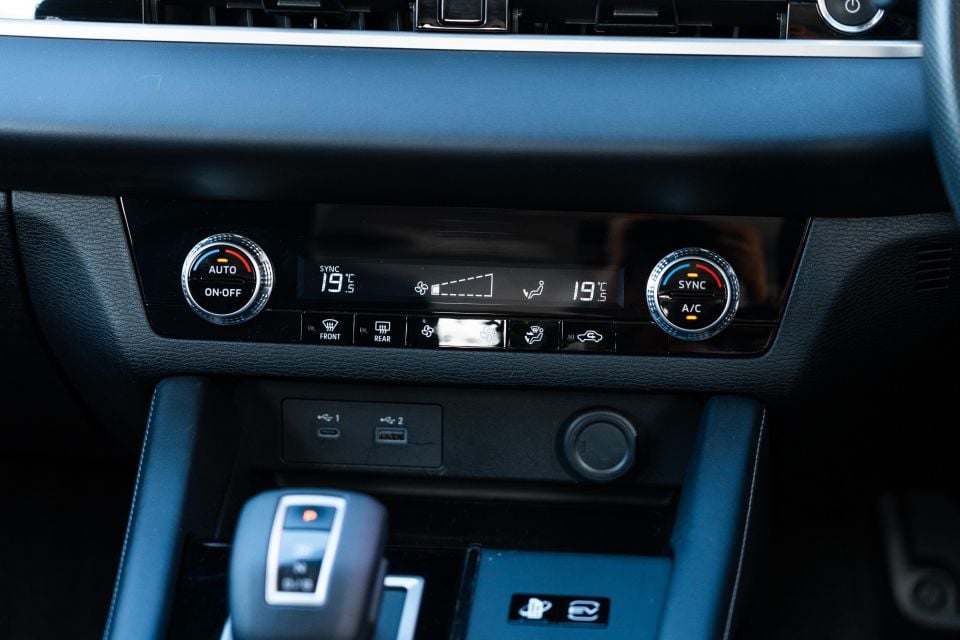

Storage and practicality up front is pretty good, with a phone-sized slot under the physical climate control cluster (it works great), without the wireless charger from higher grades. A wallet will fit there, and there’s USB-A and USB-C ports alongside a 12V socket.
There’s a lot of blank space around the shifter that could have been better utilised in my opinion, and the partial gloss black sections are a magnet for fingerprints. The shift-by-wire selector, rotary drive mode selector, as well as EV mode and one-pedal driving buttons are all easy to use and have a nice, damped action to them.
A pair of large, toothed cupholders are nestled between the front seats, and there’s a deep centre console bin that’s covered with a nicely padded leatherette lid.
Unlike the X-Trail, however, there’s no slot beneath the centre console bridge to hide handbags or other items, which is a tick for Nissan for better utilising that space.
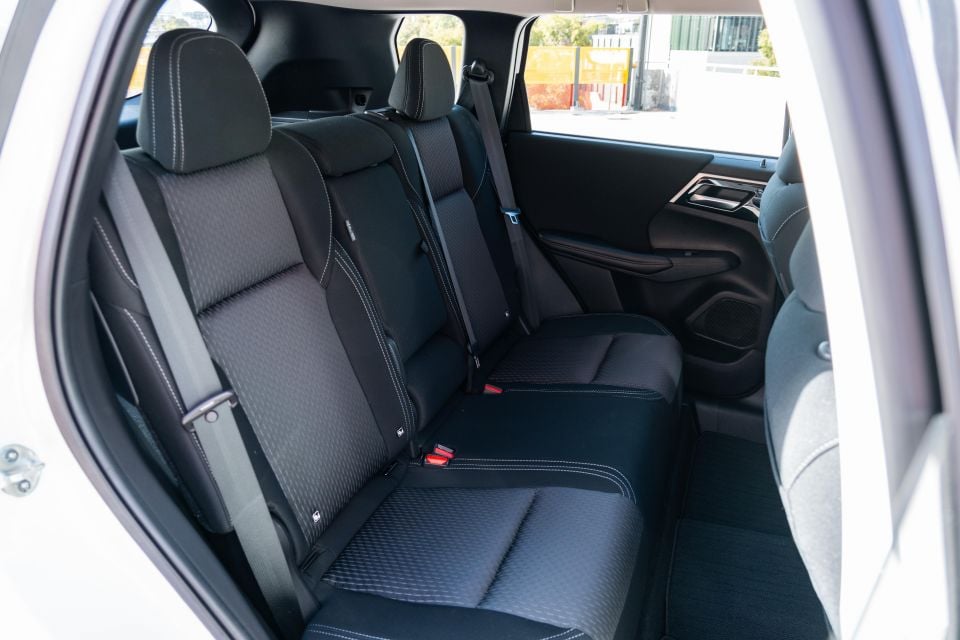
However like the X-Trail, the Outlander’s biggish dimensions for the segment allow for an excellently spacious rear seat for the class.
In this five-seat base model, you don’t need to stress about adjusting the second row for the rearmost occupants. The rear seats can be left in their rearmost position, and offer capacious leg, head and knee room for the class.
Like the front, the seats themselves are quite soft and comfy, and amenities like rear air vents, map pockets and bottle holders all help. There’s a fold-down armrest with cupholders, too.
Parents are catered for with ISOFIX anchors on the outboard seats, as well as top-tether points across all three.
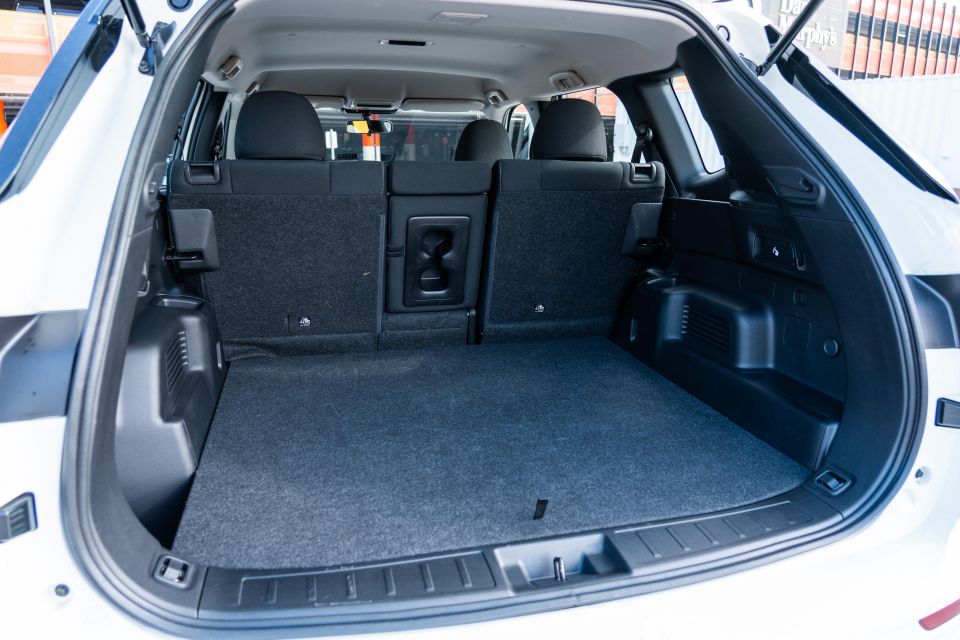
The boot measures 494 litres (VDA) with all five seats in place, which is actually 9L up on the petrol version. Fold the seats down and there’s 1414L (VDA) to the roof.
Where petrol-powered Outlanders get either a full-size spare or space-saver depending on variant, the PHEV versions make do with a tyre repair kit.
The Outlander Plug-in Hybrid EV features a 2.4-litre naturally-aspirated petrol engine running the efficient Atkinson cycle, teamed with two electric motors and a 20kWh lithium-ion battery pack.
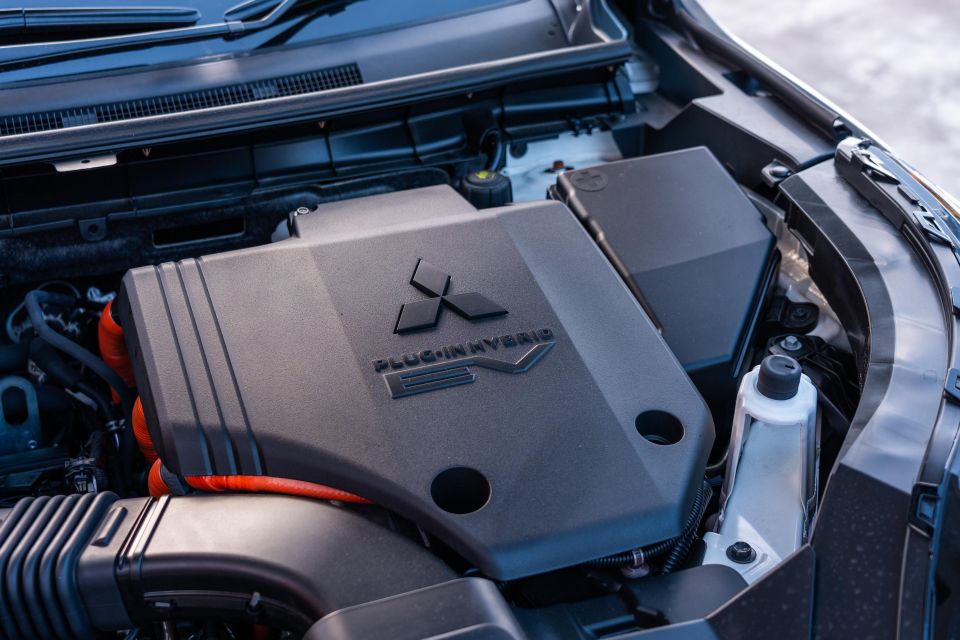
On its own the petrol engine puts out 98kW (5000rpm) and 195Nm (4300rpm). Meanwhile the front electric motor puts out 85kW, and the rear e-motor has a 100kW output.
Mitsubishi lists total system outputs of 185kW and 450Nm, which is a fair whack of grunt for this segment.
The Outlander PHEV has a claimed 84km of pure electric driving range and fuel consumption of 1.5L/100km, both on the more lenient NEDC cycle. It has a 56L fuel tank, up from 45L in the old car.
DC charging is supported via the car’s CHAdeMO port. Mitsubishi says it’ll take 38 minutes to charge from 0 to 80 per cent on a DC charger via its CHAdeMO port.
Start the Outlander with a full battery in EV mode, and you’ll be able to drive this as an electric vehicle.
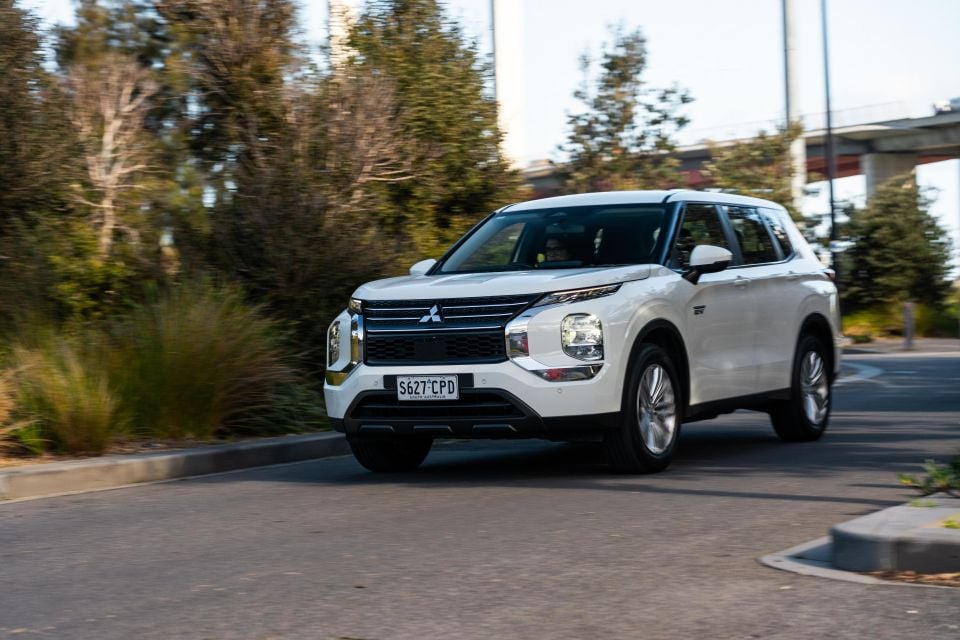
It’ll start silently in its EV setting, and uses its dual-motor electric drive system primarily while there’s sufficient charge levels in its lithium-ion battery.
The Outlander PHEV feels effortless in its performance, and is quiet and refined on the move. It’s not quite electric car fast when driving as one, but it feels more responsive and less noisy than the petrol models by some margin.
Only in ES trim do you get the smaller 18-inch alloy wheels 235/60 profile tyres, which help to address a key criticism of models with larger 20-inch rims – the ride.
Around town and on the freeway the Outlander has a supple ride that’s more befitting a family vehicle likely to be loaded up with people and their stuff. Higher grades of the Outlander get busy over tram tracks and pockmarked roads.
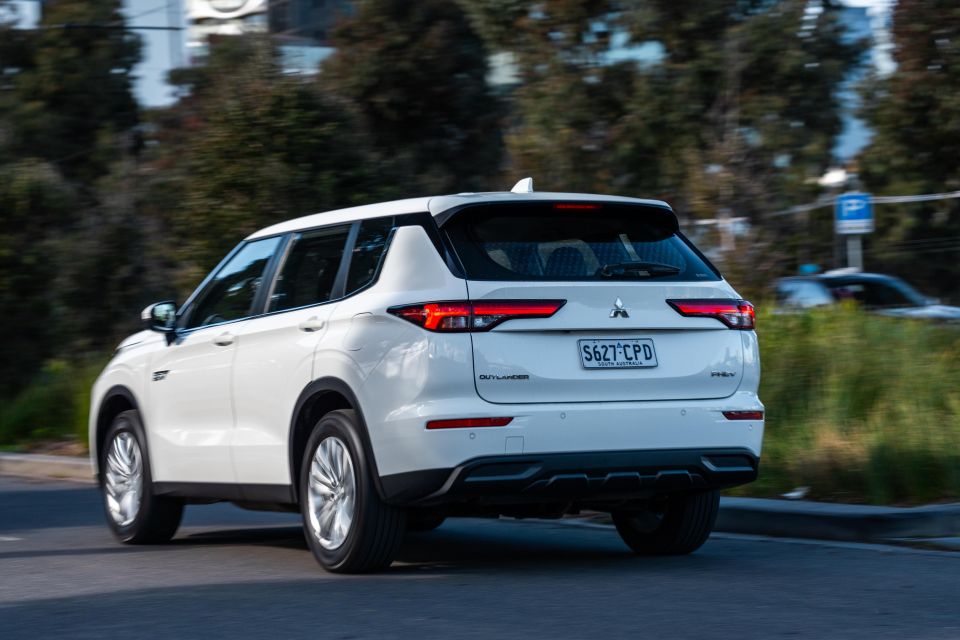
Those chubbier tyres pay dividends in transmitting less road noise into the cabin than in higher grades with low-profile rubber, so it offers a more luxurious drive all-round despite being the base variant.
As with other Outlander models, the driver controls are light and assisted, clearly focused on comfort and refinement as opposed to driver engagement. That’s no bad thing.
The light steering makes the 4710mm long and 1862mm wide Mitsubishi much easier to park – when the reversing camera is working – and less of a chore to thread through tight city streets and carparks.
Conversely, it can make the tall and wide front end feel a little vague at times, and the soft suspension means it’ll lean a bit through sharper turns. It feels more SUV-like than car-like in this regard.
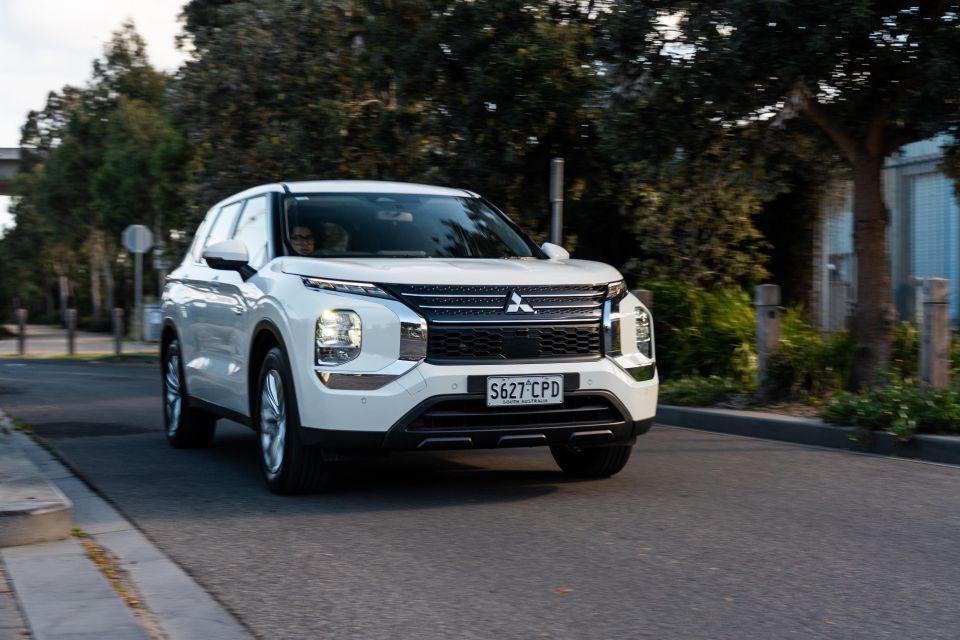
Where expert car reviews meet expert car buying – CarExpert gives you trusted advice, personalised service and real savings on your next new car.
Once the petrol engine kicks in when you’ve depleted the battery or stuck the Outlander in Hybrid or Power mode, it’ll primarily act as a series hybrid prioritising electric drive with the back-up of the petrol motor as a generator, though it’ll have all systems work together under hard acceleration.
At a cruise the electrified drivetrain shuffles between power sources to prioritise performance or efficiency. It’s quite a clever system.
Mitsubishi is to be commended for the level of insulation on the petrol engine, which is heard faintly under load but is never intrusive. It’s a stark contrast to the standard Outlander, which can get quite vocal when you sink your boot in.
Road noise is well suppressed for the class without offering luxury levels of refinement, while the Outlander’s boxy body and fat wing mirrors can at times transmit a little whistle at higher speeds. It’s otherwise pretty good for the class.

The inclusion of blind-spot monitoring with rear cross-traffic alert is welcome, as is adaptive cruise control for highway stints. While the Outlander’s adaptive cruise will bring you to a stop you have to keep re-engaging it as it doesn’t offer Traffic Jam Assist in this spec.
Lane departure warning will alert you with both chimes and vibration through the steering wheel if you drift over lane markings, and there’s a Lane Departure Prevention (keeping assist) function that will apply the brakes on one side of the vehicle at speeds over 60km/h to stop you from leaving the lane.
For a proper lane centring function you need to get the Exceed or Exceed Tourer with MI-Pilot, which adds semi-autonomous highway driving capability.
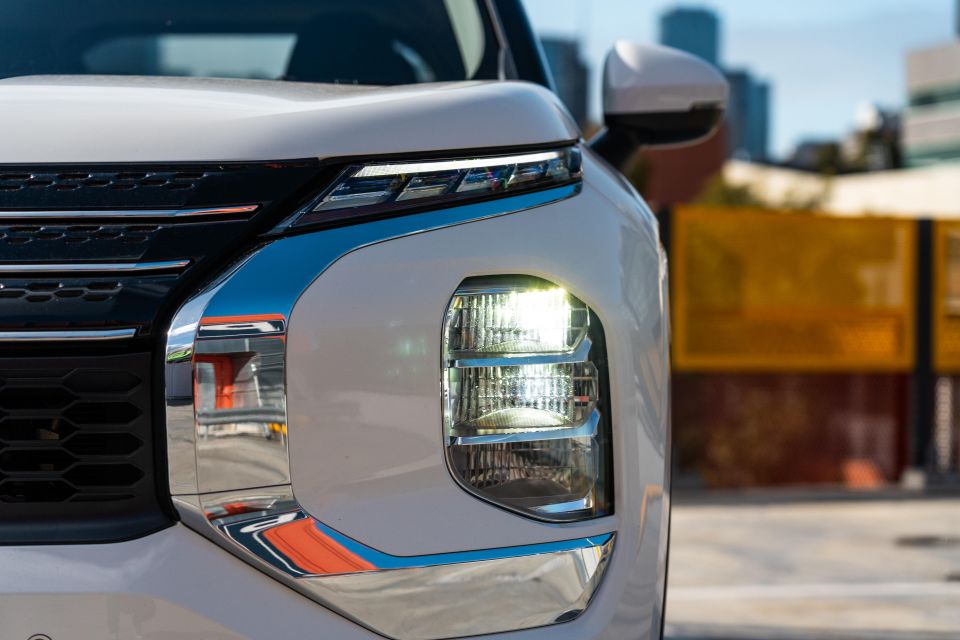

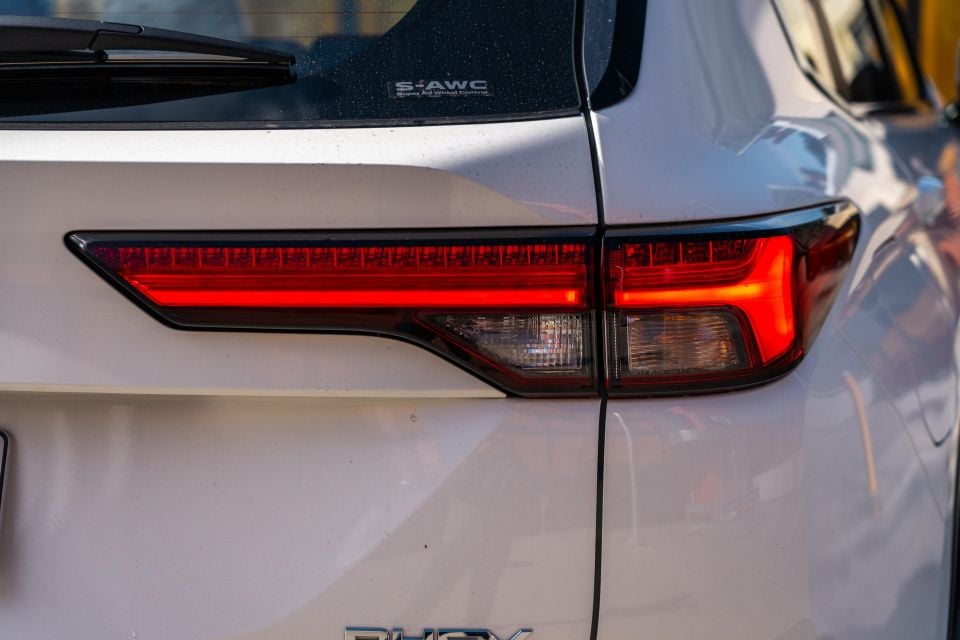

Outlander Plug-in Hybrid EV ES highlights:
The Outlander wears a five-star ANCAP safety rating based on 2022 tests – and applies to all variants including PHEV models.
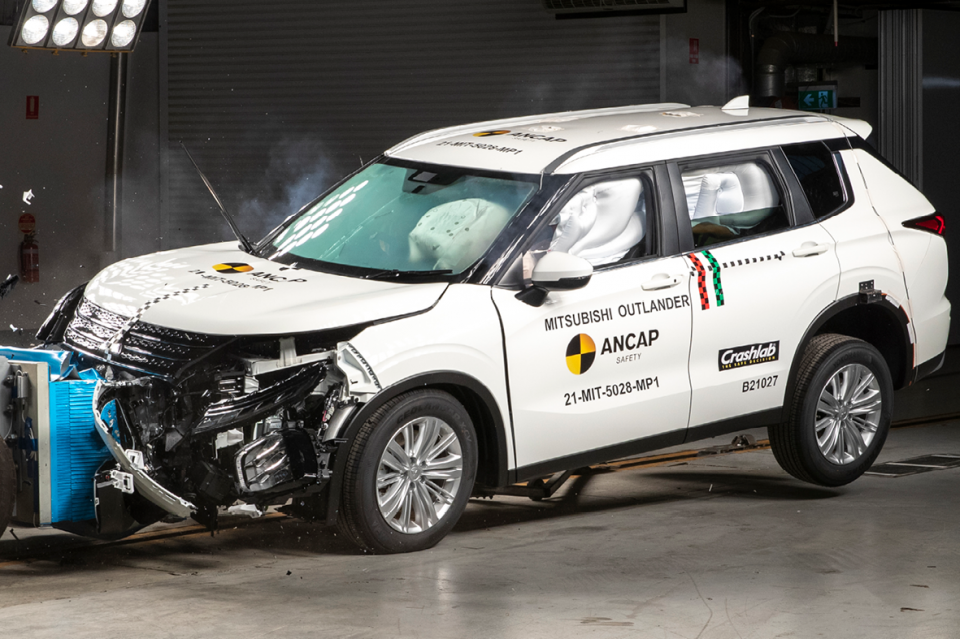
It received an adult occupant protection rating of 83 per cent, a child occupant protection rating of 92 per cent, a vulnerable road user protection rating of 81 per cent, and a safety assist rating of 83 per cent.
Standard safety features include:
Outlander Exceed adds:
The Outlander PHEV is covered by a five-year, 100,000km warranty; though this is increased to 10 years/200,000km if you service within Mitsubishi’s dealership network.

The high-voltage battery is also covered by an eight-year, 160,000km warranty.
Mitsubishi offers 10 years of capped-price servicing, with intervals of 12 months or 15,000km. Each service costs $299 except for the sixth, eighth and 10th, which cost $599, $599 and $799, respectively.
For five years you’re looking at $1495, which is on the lower side of the segment.
Real-world fuel consumption will depend on how regularly you charge the Outlander PHEV. With nightly charging I could basically do an entire day’s commuting with EV range to spare, thus achieving 0.0L/100km.
On the occasion I exceeded the battery’s EV range – which would generally hit the 60-70km mark in real-world testing – you’d see the fuel consumption creep up. With extended use as a conventional hybrid, indicated fuel consumption would rise to about the 5-6L/100km mark which still isn’t bad.
Even in its most basic trim, the Outlander Plug-in Hybrid ES is a lot of family car for the money.
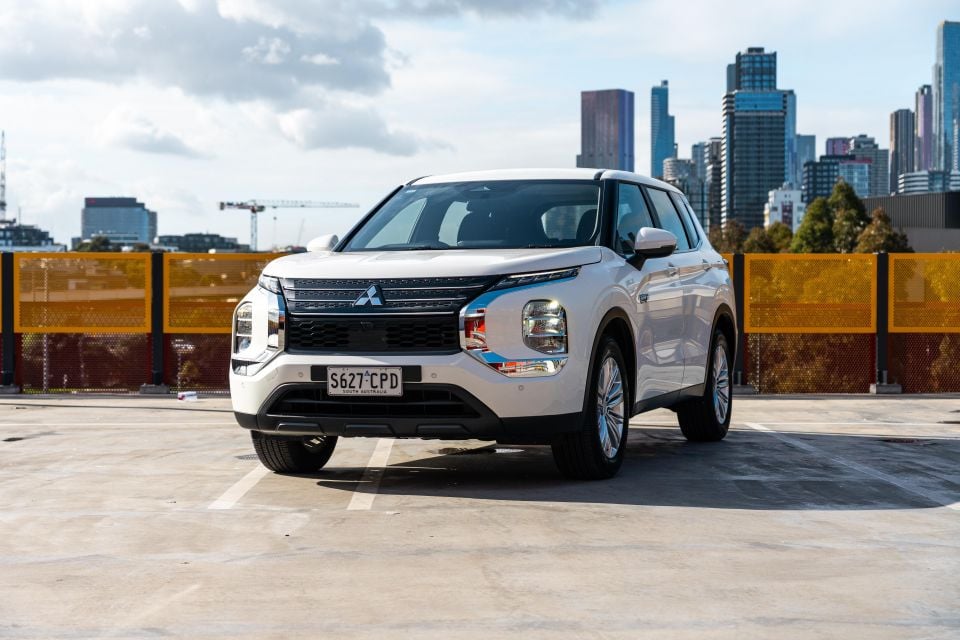
Yes you forego some luxuries you’d expect for the price point, but the Outlander PHEV offers a great balance of EV range, driving performance and refinement, and features that covers key areas and then some.
That said, the plastic steering wheel and adaptive cruise control sans Traffic Jam Assist are inclusions that would have me spend up to a higher grade.
It’s not hard to achieve 70-75km of EV driving range per charge, and there’s plenty of space to carry the family in comfort. Really, it’s the sort of no-frills family transport that should be perfect for most people.

Be smart with charging it and you’ll rarely visit the fuel station, and if you service it with Mitsubishi you’ll be covered for a decade with the warranty.
Drawbacks include the $17,000 price premium over the equivalent petrol – though if you lease it the FBT savings will close that gap, alongside the fuel savings – as well as the base cabin and tech gremlins in our test car.
But all told the Outlander Plug-in Hybrid EV is one of the most convincing PHEVs on sale, if you can get your hands on one – we understand somewhere around 1500-2000 units should arrive here in 2023, across numerous batches.
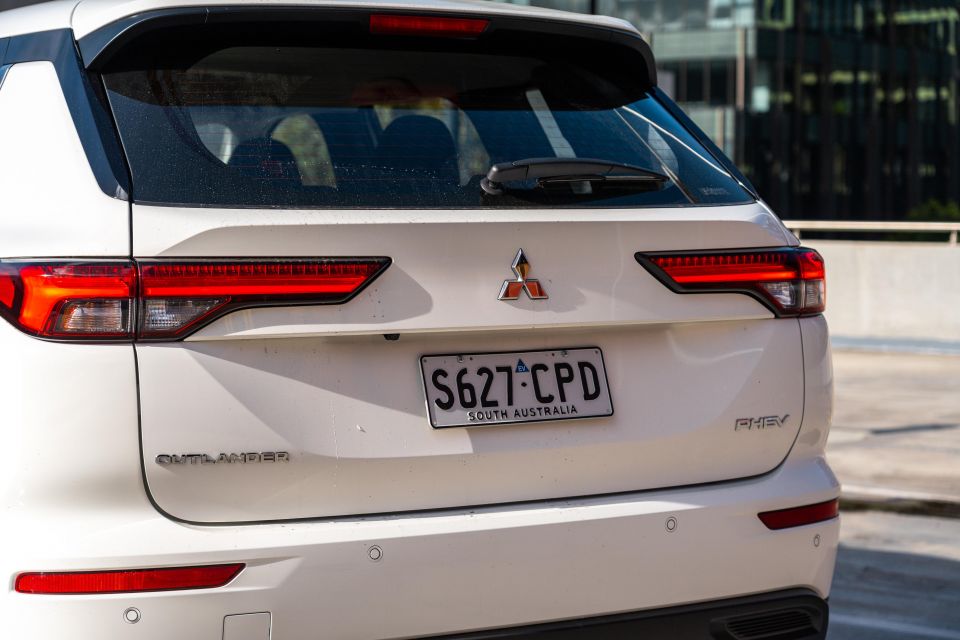
Click the images for the full gallery
BUY: Mitsubishi Outlander MORE: Everything Mitsubishi Outlander
Where expert car reviews meet expert car buying – CarExpert gives you trusted advice, personalised service and real savings on your next new car.
James Wong is an automotive journalist and former PR consultant, recognised among Australia’s most prolific motoring writers.


Matt Campbell
23 Hours Ago


Josh Nevett
4 Days Ago


Josh Nevett
6 Days Ago
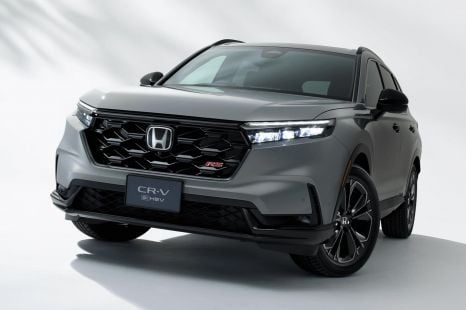

James Wong
8 Days Ago


Derek Fung
8 Days Ago


CarExpert.com.au
10 Days Ago